Family : Accipitridae

Text © Dr. Gianfranco Colombo

English translation by Mario Beltramini
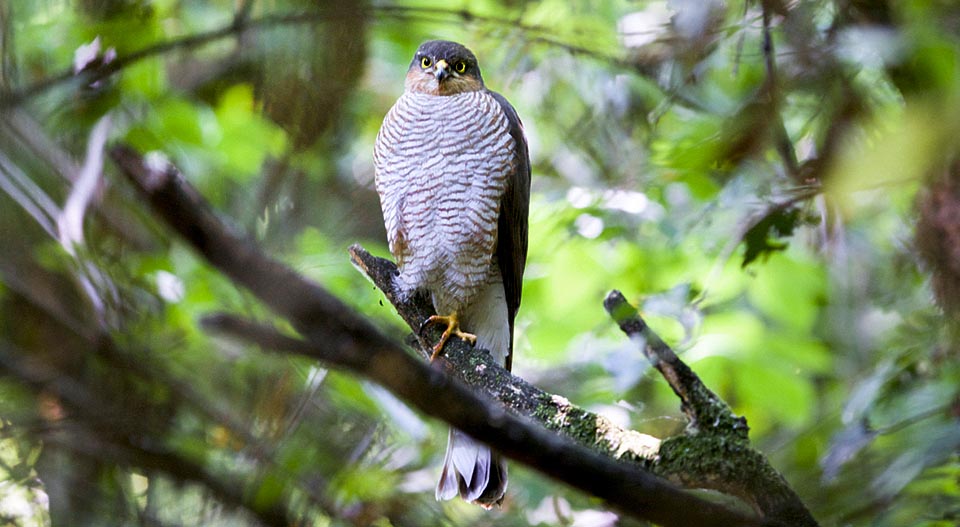
Accipiter nisus male camouflaged in the wood. It reaches 30 cm length at maximum and 170 g, against 40 cm and 300 g of the female © Gianfranco Colombo
In the Georgian port city of Poti on the Black Sea, stands probably the only statue in the world dedicated to a small bird of prey and to its use in the local falconry for catching the Quail (Coturnix coturnix), Blackbirds (Turdus merula) and migratory birds, tradition passed down over the centuries from fathers to sons until the present day.
This is the Eurasian sparrowhawk, the expression of the power, of the impetus, of the courage and of the hunting skills, maybe unparalleled among the birds of prey, in a bird that hardly exceeds the size of a pigeon but that, if necessary, has the courage to attack much larger preys, powerfuls and fast. Similar in dimension to the falcons that often frequent our country and the inhabited areas, such as the Common kestrel (Falco tinnunculus), the Lesser kestrel (Falco naumanni) and the Eurasian hobby (Falco subbuteo) show absolutely different morphological characteristics and even more a well different aggressiveness.
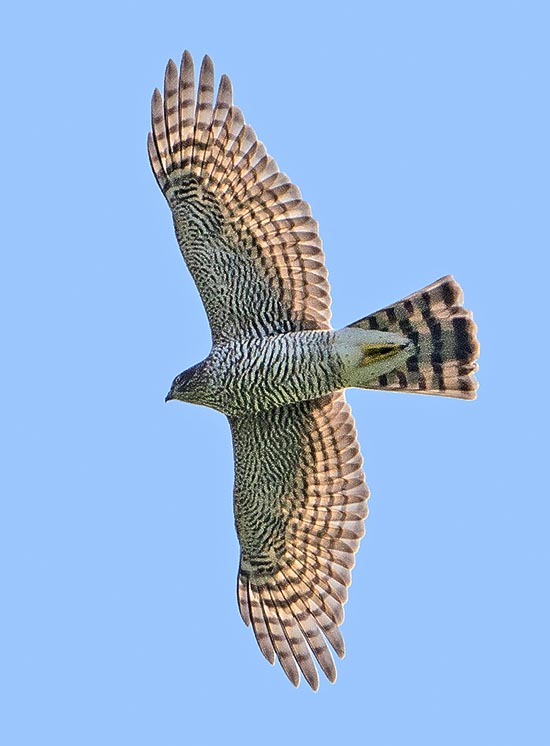
Flying female. More faded keeps the male bars with 80 cm of wingspan © Gianfranco Colombo
It would be enough to observe the claws of these last and compare them with those of the sparrowhawk and we would have immediately a clear picture of the different aggressive necessities of these birds.
The Sparrowhawk or Eurasian sparrowhawk (Accipiter nisus Linnaeus, 1758) belongs to the order of the Accipitriformes and to the family of the Accipitridae, a well distinct and defined branch in the vast world of the birds of prey, after the separation from the order of the Falconiformes.
Going back to the traditions of the falconry, these birds were very common in the medieval courts where they were the preferred by the noblewomen, seen the dimensions and the reduced weight whilst a few centuries later the sparrowhawk lost the kingship and the use was relegated to the priests and to the clergy in general with a neat distinction of genus.
The female to the priests and presbyteries, whilst the male, called in jargon “musket” and smaller than the female, to the deacons or to the lower clergy.
Musket, or moschet in old French, comes from the Latin “musca” = fly, to indicate the reduced dimensions.
Absolutely similar to the sparrowhawk but of almost double size is the Northern goshawk (Accipiter gentilis), double measures and double bravery while retaining the same elegance and agility in flight. Conversely, slightly smaller but with similar behaviours and easily confused, is the Merlin (Falco columbarius) who, however, belongs to the order of the falconiforms and to the family of the falconids.
The etymology of the vulgar name sparowhawk has old North-European origins and seems to be coming from sperhauk or spearhafoc – sparrow hawk, term still retraced by sparrow, the present common name given by the English to this bird.
The etymology of the scientific binomen gets conversely origins from the Latin for the genus and from the old Greek mythology for the species.”Accipiter” from “accipere” = to grasp violently and “nisus” from Nisos, son of Pandion, King of Megara, who was transformed in a hawk after that his city was delivered with treason by the daughter Scylla to Minos, King of Crete.
Conversely, his daughter was transformed in a lark condemned for ever to to escape the father hawk. Another legend sees instead the father Pandion transformed in fish eagle (Pandion haliaetus) and the daughter in a fish, maintaining however the concept of eternal persecution.
In Europe its is called: Sparrowhawk in nglish, Sperber in German, Gavilán Común in Spanish, Gavião da Europa in Portuguese, Sparviere in Italian and Epervier d’Europe in French.
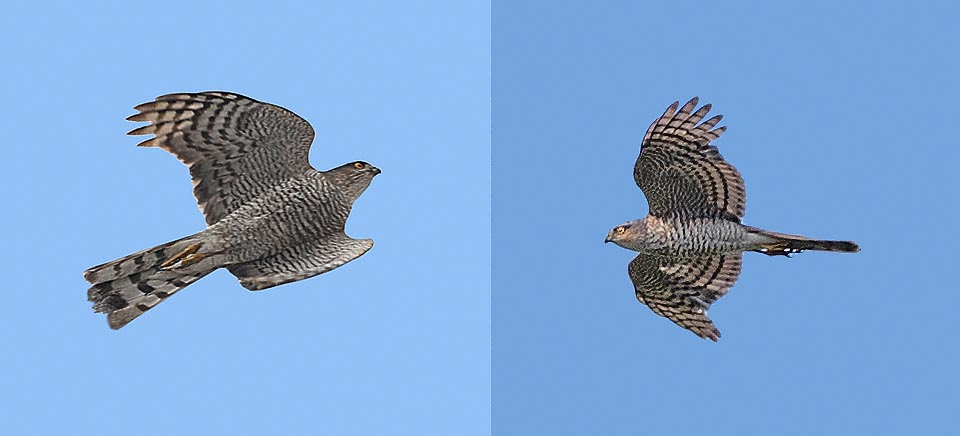
Very fast, with incredible zigzaggings that render it almost invisible while swoops on preys among branches, it usually eats small bird © Gianfranco Colombo
Zoogeography
The sparrowhawk has an Eurasian distribution with a very vast territory going from the Atlantic Ocean to the coasts of the Pacific excluding the extreme tundra, the arid and bare areas of Central Asia, the deserts and the very high Himalayan mountainous chains. It is also present in Africa with a stable population in the woody areas of Morocco, Algeria and Tunisia. The Asian populations and partially also those living in the extreme north of Europe, are migrants and during the winter transfer in the southernmost winter quarters, going down in latitude under the 40° parallel but reaching even India and the Malaysian peninsula, the Arabian peninsula and north-east of Africa up to Ethiopia and Sudan. The European population is diffusely sedentary even if subject it too to latitudinal movements but always inside the continent. In this period, the populations do overlap creating an increase of the population in the southern and Mediterranean area of the territory, where concentrates the wintering of many of the passeriforms of which they nourish.
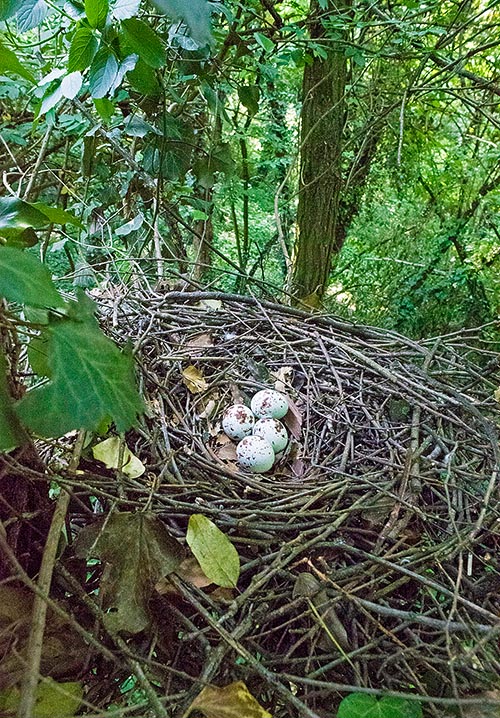
Nest in the wood. Shy and reserved, it chooses shady, isolated and inaccessible corners © Gianfranco Colombo
Several subspecies have been determined, some of which are much localized.
L’ Accipiter nisus granti, si trova solo a Madeira e nelle isole Canarie con una popolazione abbastanza esigua.
L’Accipiter nisus wolterstorffi vive solo in Corsica e Sardegna. Accipiter nisus dementievi sulle catene montuose del Centro Asia; Accipiter nisus melaschistos dall’Hindukush a sud della Cina; Accipiter nisus nisosimilis dalla Siberia alla Cina; Accipiter nisus punicus nell’Africa nordoccidentale ed in infine Accipiter nisus nisus dall’Europa alla Siberia.
Ecology-Habitat
Lo sparviere è strettamente legato ad ambienti boscosi anche di ampiezza limitata ma sempre con alberi frondosi, che sovrastano cespugli, piante arbustive e roveti, dove ripararsi e tendere i suoi agguati.
Also for the nidification it needs shady and dense corners, isolated and not easily accessible with trees even of not elevated height.
Groves of elders, of locust-trees, of young poplars even intensively cultivated covered by climbing ivy and honeysuckle and preferably always with thick underwood. At higher altitudes, it loves very much the groves of conifers and more open woods.
Being a bird of prey but not specialized in pure pursuit hunting, the sparrowhawk often uses tending traps or suddenly pouncing on the prey with short and very fast flights therefore it loves hiding in shady locations waiting for the preys to pass by in its controlled space for hunt it down and catch with the astonishing leap it is endowed.
The ability to move with amazing speed inside the thick vegetation, dodging every small obstacle with sudden but very fast zigzaggings, with unthinkable brakings, dips and sudden jerks, allow him to catch even very fast and very small preys used to live in these habitats.
During the migration and the wintering it is not rare to see it in open spaces while flying ajar wings but always fluttering, close to the ground following every small hump, depression, fences and at times following the ditches down on the water surface so close to be able to pass even under the narrow small bridges so as not to get up from its flight altitude. During these glides, helped also by the camouflaging colour of its livery that renders it practically invisible, robins and finches, blackbirds and thrushes, sparrows and tits are its usual victims.
However, it does not fail to shun these situations and occasionally, as it would like to enjoy a moment of freedom, here it is going up and, lost up in the sky, twirl together with buzzards, eagles and swifts as if it would want to show that that world is partly also its own.
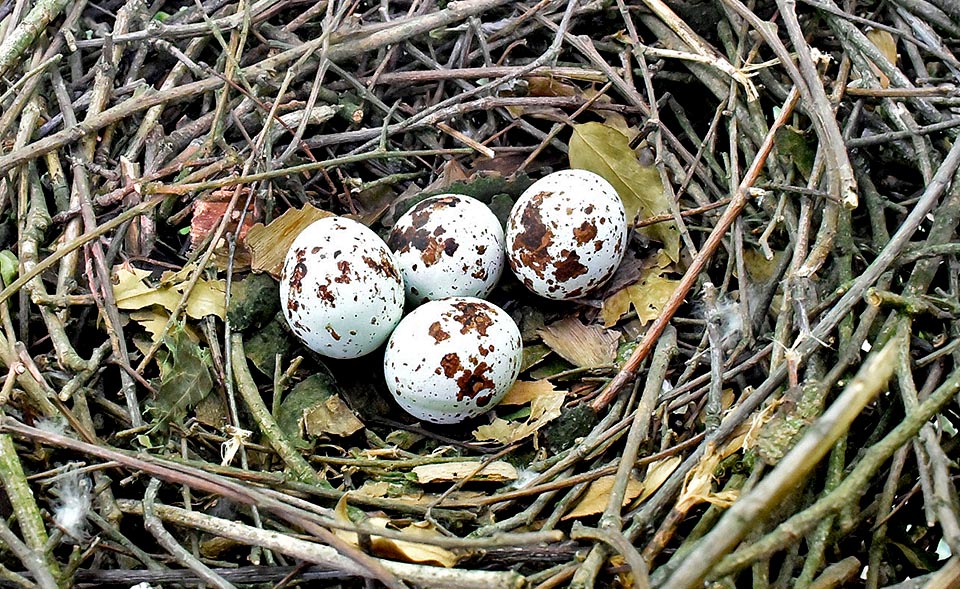
It may contain 3 to 6 bluish eggs highly marked at the centre, in the wide part, by reddish brown © Gianfranco Colombo
Morpho-physiology
The sparrowhawk is one of the smallest members of the family of the accipitrids and shows more than any other member of this group, a remarkable difference of size between male and female. Although it is usual to note a bigger size in the females of the bird of prey, paradoxically in its case the male is of about one third smaller than the female, evidencing two so much different structures to condition a different style of life, of feeding and of course, of strength. The sparrow female is almost as big as the male of the goshawk whilst the musket is 30 cm long at the most, with a wingspan of about 60 cm and a weight of about 170 g.
Conversely, the female is more than 40 cm long, with a wingspan up to 80 cm and a weight well over the 300. Also the livery shows a marked sexual dimorphism. The male has the head, shoulders and wings greyish brown with light blue reflections very pronounced with the maturity and the advancing of age.
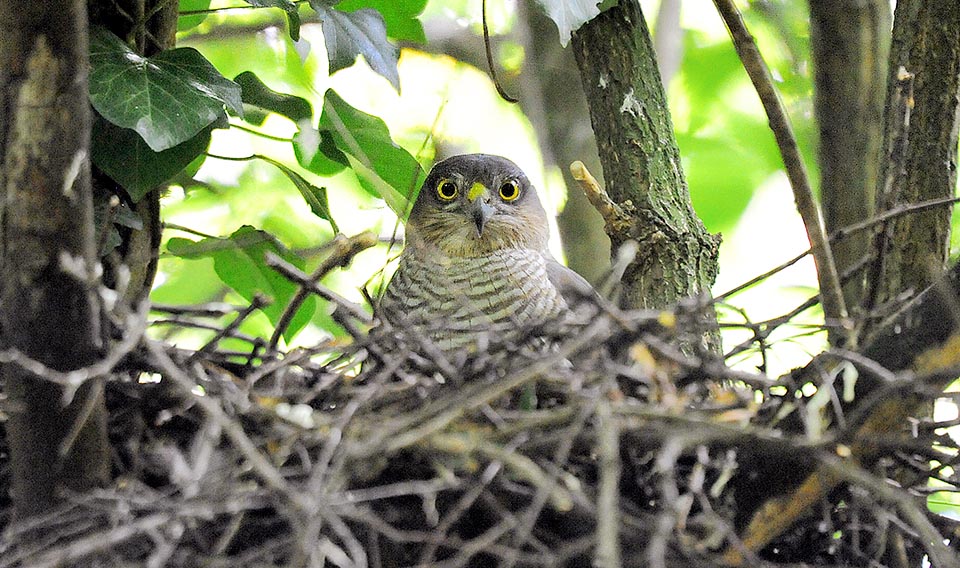
Female brooding. Incubation lasts 30-35 days with the female well camouflaged and the male watching thereabout emits alarm cries as soon intruders are seen © Gianfranco Colombo
The remiges and the tail in the lower face, are marked by ample regular black belts, well visible when in flight so to make it looking as checkered. The white chest, is delicately barred in the upper part, by transversal parallel lines of brick colour wrapping gently also the sides evidencing, always in the adults, a diffused reddish colour that from the throat goes down accentuating even more, on the chest creating a pleasant contrast with the bluish colour of the back. The head is crossed by an ample whitish superciliary belt that goes up to the nape. The iris is of a very bright yellow colour that renders the eyes of this bird penetrating and enchanting but in the mean time are frightening due to the look and the usually scowling demeanor.
The very hooked and pointed bill is black on the tip, with well extended yellow cere. The legs with much elongated and slender tarsi, with very thin toes, are also of a nice straw yellow colour. The claws are black, very pronounced and strongly pointed, a deadly weapon for blocking without hesitation every small prey.
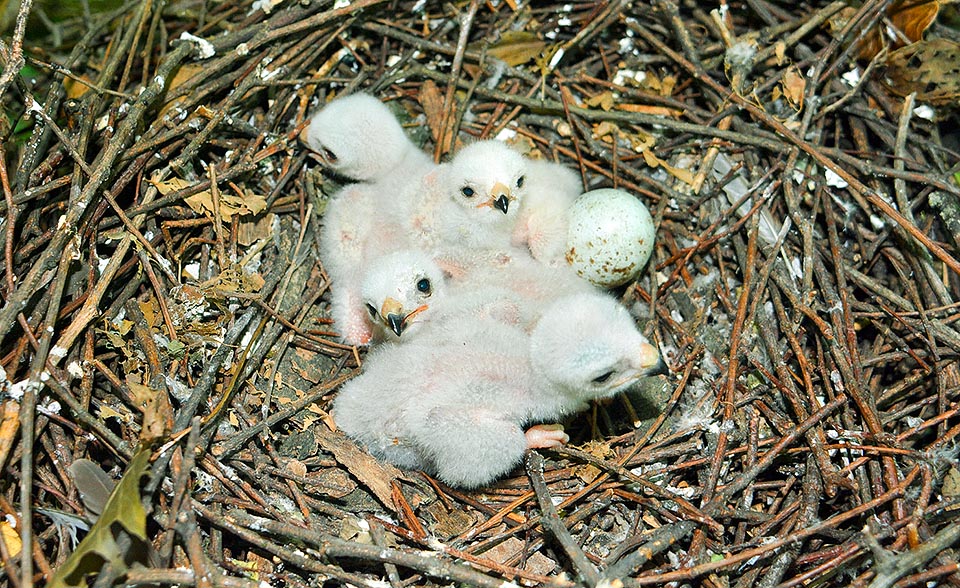
The chicks are born covered by candid down, that is lost after about two weeks, replaced then gradually by the first young livery © Gianfranco Colombo
The female has a more modest livery, as does not have either the bluish reflections of the male or the rust colour on the chest maintaining however all the streaks and strikethroughs of the partner.
The young have a more modest plumage but that anyway copies faithfully what will be their livery when adult. The strikethrough on the chest is more marked and evidences vertical lines often like a drop instead of horizontal as the adults.
Two remarks concerning their livery. In the old popular tradition, dating since Aristotle times, it was claimed that the common cuckoo (Cuculus canorus), in winter was becoming a sparrowhawk such is the similarity between the two birds. In memory of this conjecture, still now a Po Valley proverb says: “d’istà cucheto, d’inverno falcheto”. In summer cuckoo, in winter hawk.
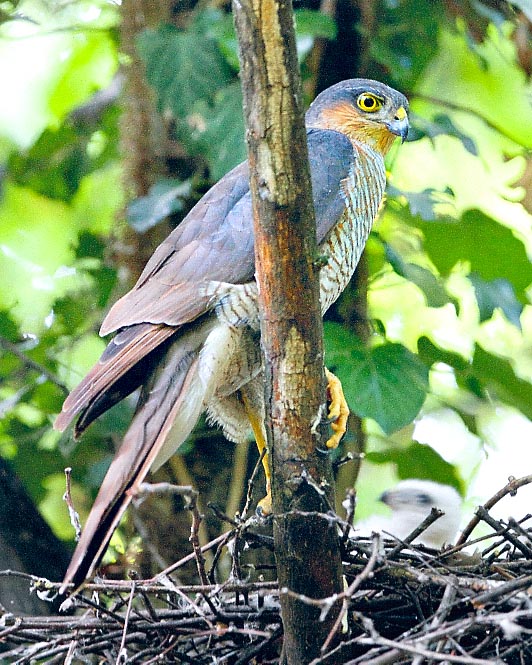
Male by the nest. The throat is reddish, in elegant contrast to the head colour, the shoulders and the wings, that are greyish brown with bluish reflections © Gianfranco Colombo
The flight of the sparrowhawk cannot be mistaken. Very rounded wings, very fast wing beats of few seconds, with rapid and light glides immediately followed by other beats. In these flights the speed is somewhat reduced and has nothing of comparable with the pursuits when it is hunting.
During these beats the leap and the jerk betwwen a tack, a stoop or a sudden rise is impressive and so luch fast to be imperceptible to the eye.
The rounded wings and the long tail are crucial accessories for rendering possible these manoeuvres.
The sparrowhawk, the female in particular, may be easily mistaken with the goshawk who, though larger, has the same modalities of flight, the same silhouette and the same habitat.
Ethology-Reproductive Biology
The sparrowhawk is a very shy bird and its nidification often goes unnoticed even if situated in laces of common passage.
The nest is a massive and disorderly construction of small branches furnished with small leaves and thin rootlets that form an ample and little deep cup. During the brooding the nest fills up of down released by the female during her stay on the nest. It is usually built on horizontal branches, at the junction of a bifurcation at variable heights, but never too high. In the lowland thickets of the Po Valley it loves quite a lot to build it close to a branch covered by climbing ivy often at a height less than three metres.
Once the couple is formed, the nest is done quite quickly taking often advantage of the same used the previous year or one of the several ones it uses to build during every nuptial period. It is very faithful to the native site and the various nidifications may happen year after year always within a few metres one from the other. We said of the privacy and discretion of these birds during the nidification period. In such period the sparrowhawks seem to disappear from circulation even if occupying thickets of on extremely limited extension.
The male watches staying concealed on some branches of the second line of trees that faces the open spaces, position from which it sees perfectly what is going on around and is not in any way seen. The female while brooding observes carefully each small movement inside the wood, always with the hearing tended towards any possible cry of the partner. In fact, the only advice that there are sparrowhawks is the alarm cry that initially the male and then the female do emit as soon as an intruder enters their territory. A rapid and sharp ke ke ke emitted by the male and slowly more rhythmic by the female. In any case, also in this instance it is impossible to see them.
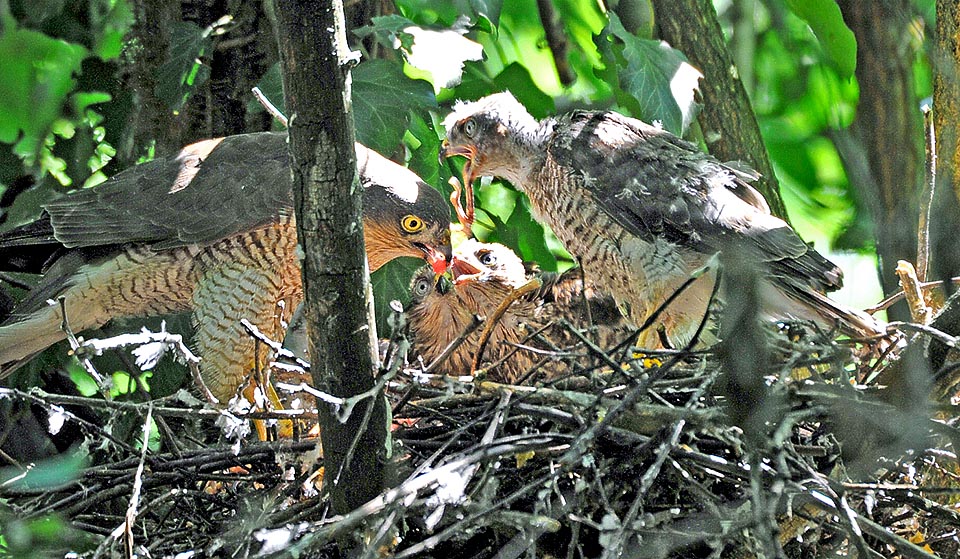
It’s the female nourishing the chicks in the nest whilst the male is charged of catching of preys that are given the female well plucked ready for consumption. If she accidentally dies, also the chicks die starving as the father goes on in carrying food but is not programmed for nourishing them © Gianfranco Colombo
The female lays 3 to 6 light blue cream eggs strongly marked of reddish brown in the wider part of the egg. The reproductive cycle of the sparrowhawk lasts totally about 130 days, 30/65 of them for brooding and more than 70 for the flight off and the independence of the young. The chicks come to life covered by a candid down they lose after about a pair of weeks and is then replaced gradually by the first juvenile livery.
It’s the female who nourishes the chicks in the nest whilst the male is in charge of the catching of the preys that are given to the female ready for consumption. As a matter of fact, every prey is duly plucked far away from the nest often in usual places called plucking posts and that collect practically the checklist of the seized preys.
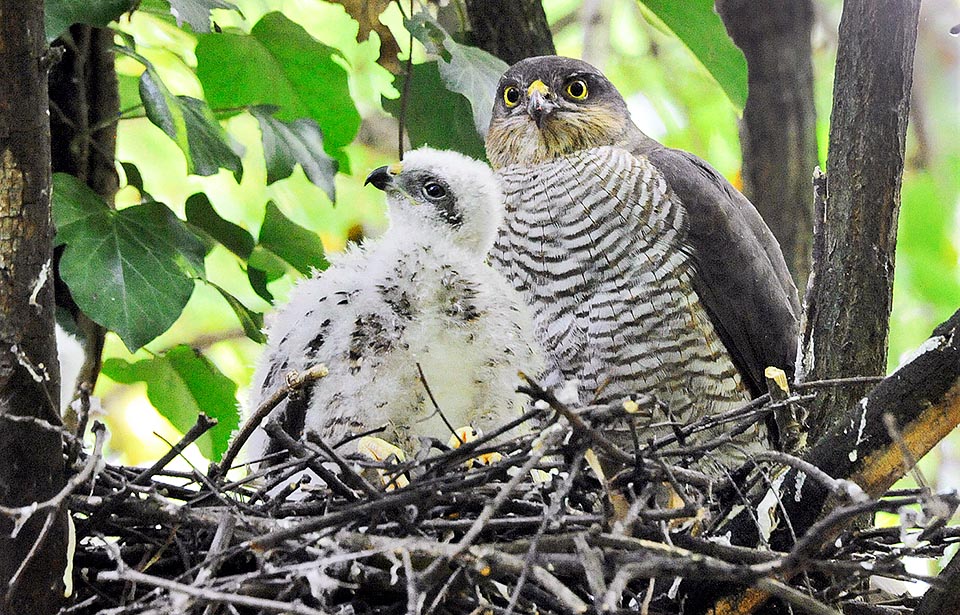
Mother attentive with growing chock. When they get the adults size the young pass on the near branches because the nest could not sustain the weight of the big family © Gianfranco Colombo
The victims are usually small passeriforms when caught by the male whilst the dimensions increase up to turdids and columbids if carried by the female.
The young, when they reach the size of the parents but are still unable to fly, abandon the nest and perch on the nearby branches spending in this position the last weeks before taking their first flight. Only telling clue that easily reveals the presence of the brood, is that all around at the foot of the nest, the ground gets white due to the whitish droppings emitted abundantly. They then stay with the parents for 4 weeks more till the total independence. The sexual maturity happens on the 2nd -3rd year. They have a lifespan of some years even if its has been noted a case of a specimen who lived more than 20 years.
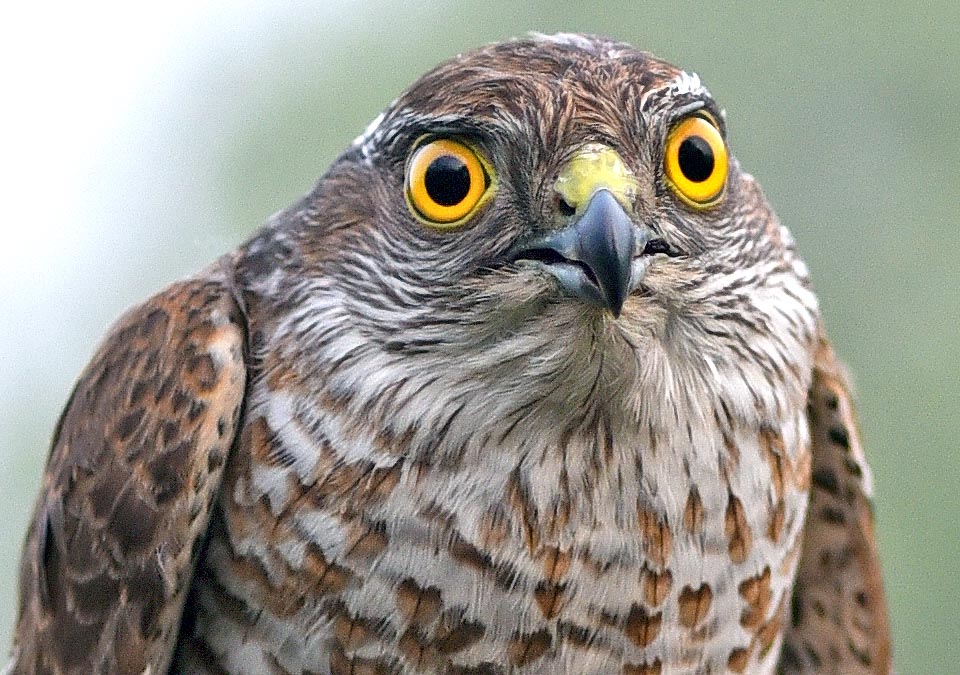
Young male. Accipiter nisus has an immense Euro-Asian distribution, from Atlantic to Pacific, with stable populations also in North Africa © Gianfranco Colombo
The sparrowhawk, very common in the Anglo-Saxon world, has often entered the literature of this country. Shakespeare cites it in some of his comedies as well as Tennyson in his poems but other writings often do refer to it reminding its aggressiveness, its stateliness but in the same time the delicacy of its flight.
Synonyms
Falco nisus Linnaeus, 1758.
→ To appreciate the biodiversity within the birds of prey and find other species please click here.
